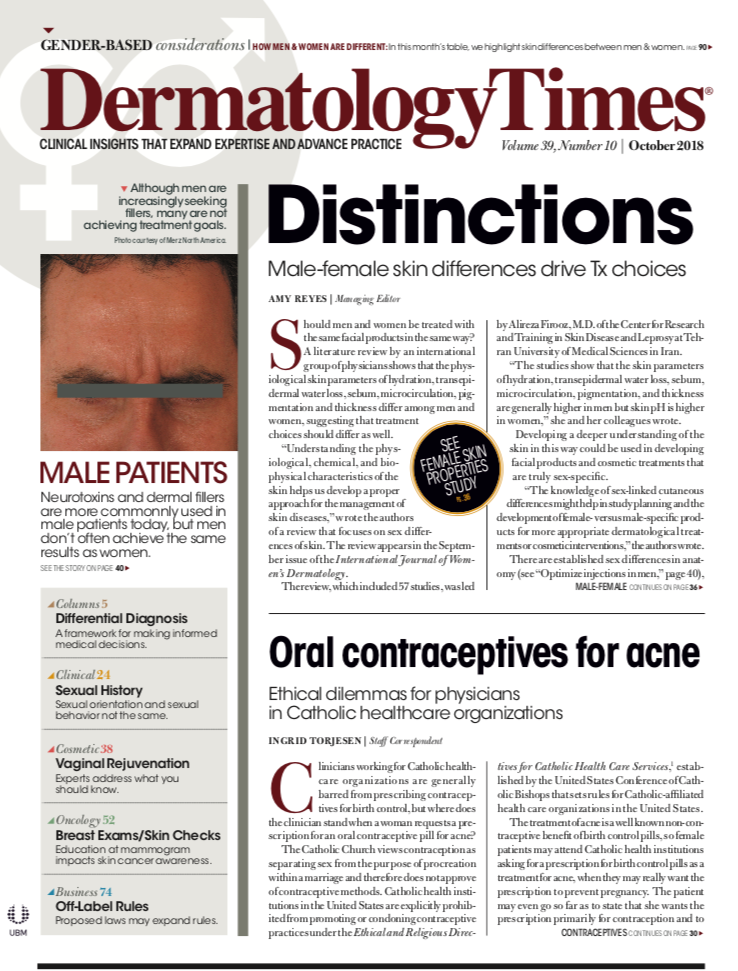- Acne
- Actinic Keratosis
- Aesthetics
- Alopecia
- Atopic Dermatitis
- Buy-and-Bill
- COVID-19
- Case-Based Roundtable
- Chronic Hand Eczema
- Drug Watch
- Eczema
- General Dermatology
- Hidradenitis Suppurativa
- Melasma
- NP and PA
- Pediatric Dermatology
- Pigmentary Disorders
- Practice Management
- Precision Medicine and Biologics
- Prurigo Nodularis
- Psoriasis
- Psoriatic Arthritis
- Rare Disease
- Rosacea
- Skin Cancer
- Vitiligo
- Wound Care
Publication
Article
Dermatology Times
A critical first step in defining great problems
In this month's Innovation Column, Drs. Steve Xu and William Ju discuss the unique advantage dermatologists have when it comes to innovation in healthcare.
(wladimir1804 - stock.adobe.com)

When it comes to innovation in healthcare, dermatology has a unique advantage.
More often than not, the problems that afflict our patients and the problems that frustrate us as physicians and other healthcare providers are right in front of our eyes. We have a visual, tactile and visceral connection to the problem, which is something much more powerful than any CT image could ever do.
This front row seat and multi-sensory connection to patient suffering allows more profound insights into the clinical, psychological, pathophysiologic and socioeconomic drivers of the problem.
Why focus on this problem? Isn’t innovation about new solutions? Too often in biomedical innovation, new and exciting technologies with incredible capabilities and features are simply targeting the wrong problem leading to an eventual loss of resources and time and failure. Truly breakthrough and successful innovation often starts with a clear and compelling problem statement.
THE RISKS OF FAILURE
In biomedical innovation, there are many risks of failure. These can be categorized in several different ways (e.g. scientific, medical, regulatory, payor, financing, skills of the team, etc.).
1. Technical risks
Broadly, we think of risk in two main ways for innovations. The first risk is a technical risk. Is the medical device safe and effective? Can the production process from lab prototype be scaled for mass manufacturing? Is the drug targeted enough with an acceptable therapeutic window? Would the clinical trial be reasonable to conduct in time and cost?
With this type of risk, the innovator and entrepreneur may be able to exert somewhat greater control. There is an inherent understanding and ability to design robust experiments to assess the biologic and engineering complexities, test for toxicity, and frame the regulatory risks, for example.
2. Market risk
The second major category is a market risk. Broadly, market risk equates to instances where your technology works as predicted, but no one will buy it. Market risk is something an innovator has considerably less control over. There is greater uncertainty and this is where understanding the problem becomes so critical.
If an innovator misjudges a problem, then the chances their technology or solution will succeed in the marketplace drastically decreases. Conversely, a deep understanding of the problem helps enable the innovator to shape the product’s target profile to match the expectations of the patient and the provider, thrive in the competitive landscape and mitigate regulatory and reimbursement challenges.
Stanford University’s bio-design process directs the innovator through the process of problem identification into a clear needs statement that is then solidified prior to any discussion around a solutions.1 Based on the tremendous breakthroughs in product innovation under the leadership of R. Rox Anderson M.D. at the Wellman Center for Photomedicine and Lilit Garibyan, M.D., Ph.D., Dr. Anderson created the Magic Wand Initiative at Massachusetts General Hospital.2 It is a program that centers on problem-driven innovation and research with clinician leadership. At the core of the Magic Wand approach is its relentless focus on a clinical problem that is worth solving, which clinicians often times understand the best.
Each year, Advancing Innovation in Dermatology takes a small group of exceptionally talented, inquisitive and motivated residents and early-career dermatologists through a year of virtual lectures and experiential activities with the primary goal of leaving with a developed needs statement for a business solution.

At Northwestern University, it has been a privilege to work with medical students and trainees who are excited about clinical problems in dermatology. The first inclinations are usually to pursue a mobile phone app idea, device sketch or repurposed drug. The challenge we see is in peeling back the layers of a problem first â long before we consider solutions.
For example, a talented third-year medical student interested in dermatology quickly recognized that if only our skin cancer patients were better about using sunscreen, we would prevent huge numbers of skin cancers every year.
Her needs statement was, “We need to find ways to increase sunscreen use in high-risk patients.” On face value, this statement seems reasonable. But, it would benefit from additional refinement. Increasing sunscreen use is laudable, but isn’t the real interest in reducing the downstream sequelae of excess UV radiation in high-risk patients? Sunscreen is just one potential strategy. For the next iteration, part of the approach was sub-categorizing high-risk patients by factors such as age, gender, previous diagnoses, family history, technology literacy, and socioeconomic status. From her original needs statement, the next iteration generated ones that would enable (hopefully) a host of more targeted solutions that reduce both the technical and market risk.
The following needs statements provide an example of the evolution of the needs statement from the initial draft to more specific versions. The process emphasizes embracing the problem and knowing it deeply. By truly understanding the clinical problem worth solving, we can help avoid the common mistake of developing a solution no one wants.
ABOUT THE AUTHORS:Dr. Xu is an instructor in dermatology at Northwestern University Feinberg School of Medicine; medical director, Center for Bio-Integrated Electronics, Simpson Querrey Institute for Bionanotechnology, Northwestern University; and, co-founder, Advancing Innovation in Dermatology Accelerator Fund
Dr. Ju is co-founder of Advancing Innovation in Dermatology, Inc. and co-founder of the Advancing Innovation in Dermatology Accelerator Fund
DISCLOSURES
All authors are members of Advancing Innovation in Dermatology, Inc., a registered 501(c)(3) organization designated as a public charity in the United States.
REFERENCES
1) Biodesign: The Process of Innovating Medical Technologies 1st Edition by Stefanos Zenios (Author), Josh Makower (Author), Paul Yock (Author), Todd J. Brinton (Author), Uday N. Kumar (Author), Lyn Denend (Author), Thomas M. Krummel (Author) (1) ISBN-13: 978-0521517423; ISBN-10: 0521517427
2) Lilit Garibyan, MD, PhD; R. Rox Anderson. "Increasing Clinical Faculty Engagement in Problem-Driven Research. The “Magic Wand” Initiative at Massachusetts General Hospital," JAMA Dermatology. May 2017. DOI:10.1001/jamadermatol.2017.0286

























